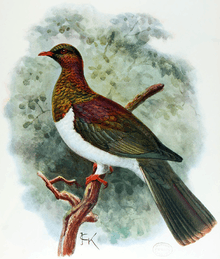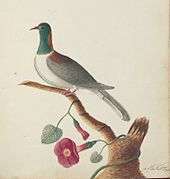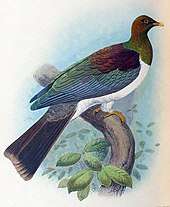Norfolk pigeon
The Norfolk pigeon or Norfolk Island pigeon (Hemiphaga novaeseelandiae spadicea), sometimes called a wood quest, was a subspecies of the New Zealand pigeon that inhabited Norfolk Island. This population probably colonized Norfolk Island from New Zealand during the Pleistocene[1]. It became extinct around the turn of the 20th century.
| Norfolk pigeon | |
|---|---|
 | |
| Illustration by Keulemans, 1907 | |
| Scientific classification | |
| Kingdom: | Animalia |
| Phylum: | Chordata |
| Class: | Aves |
| Order: | Columbiformes |
| Family: | Columbidae |
| Genus: | Hemiphaga |
| Species: | H. novaeseelandiae |
| Subspecies: | H. n. spadicea |
| Trinomial name | |
| Hemiphaga novaeseelandiae spadicea Latham, 1801 | |
Ecology


The abundance of the Norfolk pigeon at the time of the island's settlement is unknown. Early records indicate the presence of the bird, but do not contain any information on its numbers. Based on the behaviour of the other subspecies, it is likely that the bird relied upon fruiting plants for food.[2]
Extinction
The extinction of the Norfolk pigeon was caused by a combination of the introduction of cats and weasels, habitat destruction by human settlers, and direct hunting by humans. Prior to European settlement, the bird had been hunted by Polynesian settlers of the island. When Europeans reached the island, however, the birds remained and the Polynesians did not.[3] The Europeans took up the bird as a food source. An officer of the penal colony there, Ensign Abel Dottin William Best, recorded the species as still quite common in 1838, with his journals mentioning his successful hunting of 72 birds, including 25 on September 18, 1838.[4] The last sighting occurred in 1901.[5] Direct hunting by humans was probably the dominant cause of extinction.[2]
Specimens
The first description of the species was given by John Latham, in his 1801 work Supplementum Indicis Ornithologici.[6] Twenty specimens of the Norfolk Pigeon are known. Three of these are in the Natural History Museum, Leiden,[7] two in the Natural History Museum New York and one specimen in World Museum Liverpool.[1] DNA extracted and sequenced from toepad tissue revealed that the Norfolk Island pigeon is genetically sister to the New Zealand Hemiphaga novaeseelandiae population[1].
Memorials
The Government of Norfolk Island released a stamp commemorating the bird on February 24, 1971.[8]
References
- Goldberg, Julia; Trewick, Steven A.; Powlesland, Ralph G. (2011). "Population structure and biogeography of Hemiphaga pigeons (Aves: Columbidae) on islands in the New Zealand region: Population structure of pigeons in New Zealand". Journal of Biogeography. 38 (2): 285–298. doi:10.1111/j.1365-2699.2010.02414.x.
- Stephen T. Garnett & Gabriel M. Crowley (2000). "New Zealand Pigeon (Norfolk Island)" (PDF). The Action Plan for Australian Birds 2000. Environment Australia. Archived from the original (PDF) on 2011-05-21. Retrieved 2008-12-08.
- Richard N. Holdaway & Atholl Anderson (2001). "Avifauna from the Emily Bay Settlement Site, Norfolk Island:A Preliminary Account" (PDF). Records of the Australian Museum. 27: 85–100. doi:10.3853/j.0812-7387.27.2001.1343. Retrieved 2008-12-10.
- James L. Moore (December 1985). "Ensign Best's bird observations on Norfolk Island" (PDF). Notornis. Ornithological Society of New Zealand. 32: 319–322. Archived from the original (PDF) on 2008-10-17. Retrieved 2008-12-10.
- Day, David (1989). The Encyclopedia of Vanished Species. Hong Kong: Mclaren Publishing Limited. ISBN 0-947889-30-2.
- R. Schodde, Australia Bureau of Flora and Fauna, I. J. Mason, Australian Biological Resources Study, W. W. K. Houston, A. Well (1997). Zoological Catalogue of Australia. CSIRO Publishing. p. 53. ISBN 0-643-06037-5.CS1 maint: multiple names: authors list (link)
- "Naturalis - Extinct bird: Hemiphaga novaeseelandiae spadicea (Norfolk Island Pigeon)". Nationaal Natuurhistorisch Museum. Archived from the original on 2011-06-08. Retrieved 2008-12-08.
- "Bird Stamps Related To Captain James Cook" (PDF). Captain Cook Society. 2005. Retrieved 2008-12-10.
